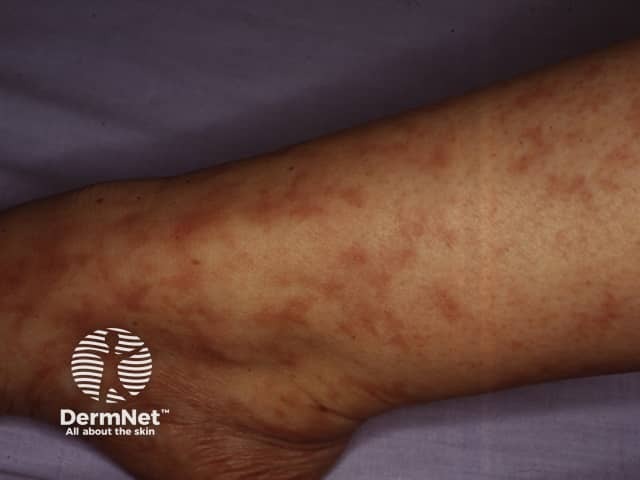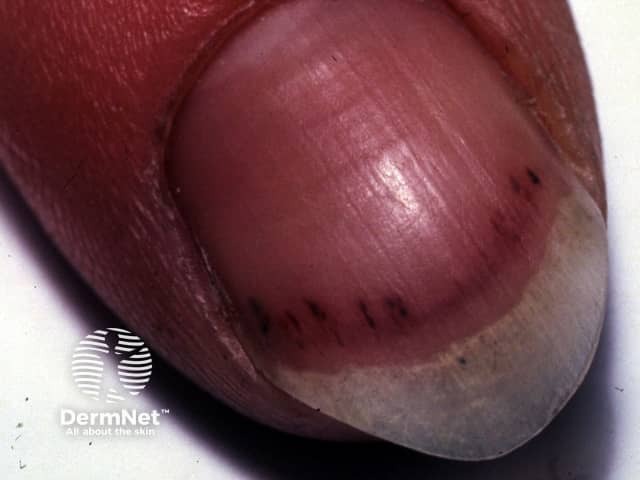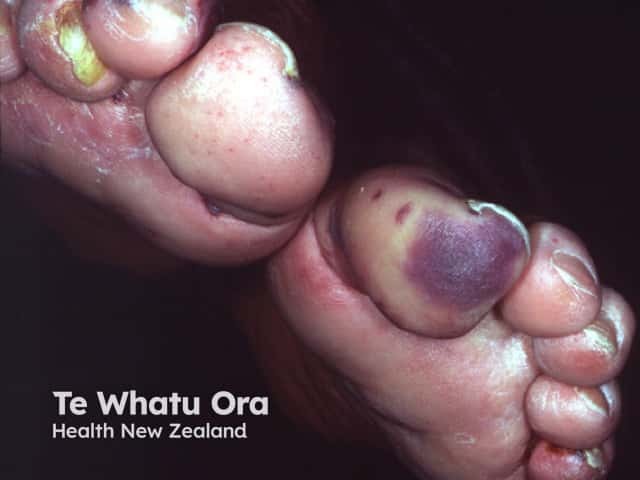Main menu
Common skin conditions

NEWS
Join DermNet PRO
Read more
Quick links
Antiphospholipid syndrome — extra information
Autoimmune/autoinflammatory Blood vessel problems
Antiphospholipid syndrome
Author: Vanessa Ngan, Staff Writer, 2003. Updated by Dr Ebtisam Elghblawi, Tripoli, Libya, April 2017.
Introduction Causes Demographics Signs and symptoms Diagnosis Treatment
What is antiphospholipid syndrome?
Antiphospholipid syndrome is an acquired autoimmune disorder characterised by recurrent arterial or venous thrombosis and/or pregnancy losses, in the presence of persistently elevated levels of anticardiolipin antibodies and/or evidence of circulating lupus anticoagulant (these abnormalities are detected by blood tests). Antiphospholipid syndrome can be primary or secondary.
- Primary antiphospholipid syndrome occurs when there is no evidence of associated diseases.
- Secondary antiphospholipid syndrome is associated with an underlying disease, usually systemic lupus erythematosus, and drugs, including levamisole-adulterated cocaine.
Seronegative antiphospholipid-like syndrome is a similar disease where antiphospholipid antibodies are not detected.
What is the cause of thrombosis in antiphospholipid syndrome?
The mechanisms resulting in a hypercoagulable state and recurrent thrombosis are not yet defined. Complement activation is involved. The 'two-hit' theory has associated the onset of thrombosis with increasing age, hypertension, diabetes, obesity, smoking, pregnancy, surgery, and other genetic hypercoagulable states.
Who gets antiphospholipid syndrome?
Antiphospholipid syndrome is generally diagnosed in young to middle-aged adults. However, it can affect children and adults of all ages.
Secondary antiphospholipid syndrome is more common in females than in males, most likely because systemic lupus erythematosus and other connective tissue disorders have a female predominance.
Patients have a history of spontaneous miscarriage, deep vein thrombosis (DVT), pulmonary embolism, myocardial infarction, or stroke.
What are the signs and symptoms of antiphospholipid syndrome?
To classify as antiphospholipid syndrome a patient must have at least one of the two following clinical manifestations in addition to the presence of certain laboratory abnormalities.
- Venous or arterial thrombosis: this may involve the cerebral vascular system, coronary arteries, pulmonary emboli or thromboses, hepatic or renal veins, ocular veins or arteries
- Recurring miscarriages or premature births: patients may have pre-eclampsia in pregnancy and babies may be unexpectedly small


Splinter haemorrhages

Cholesterol emboli
Other symptoms are not part of the classification criteria.
Skin disorders in antiphospholipid syndrome
Livedo reticularis affects up to 80% of people with antiphospholipid antibodies. Other features include:
- Splinter haemorrhage (one or more red or black streaks on a nail)
- Leg ulcers, both arterial and venous ulcers
- Superficial thrombophlebitis
- Blue toe syndrome
- Vasculitis involving medium-sized and small vessels
Neurological defects in antiphospholipid syndrome
- Migraine headaches
- Seizures
- Stroke
- Multi-infarct dementia
Cardiac abnormalities in antiphospholipid syndrome
- Heart murmur
- Cardiac valve vegetations
Eye disorders in antiphospholipid syndrome
- Blindness
Blood abnormalities in antiphospholipid syndrome
- Thrombocytopenia (low platelet count)
- Haemolytic anaemia (low red cell count due to the destruction of the cells by antibodies)
Catastrophic antiphospholipid syndrome refers to blockage of blood vessels in multiple organs, which may occur over days or weeks. The condition is serious and often lethal.
How is antiphospholipid syndrome diagnosed?
The antiphospholipid syndrome has various clinical manifestations and is associated with a range of autoantibodies. In 2006, revised criteria for the diagnosis of antiphospholipid syndrome stated that at least one clinical criterion and one laboratory criterion must be present [1]. The name 'lupus anticoagulant' is misleading because not all patients with a positive result have systemic lupus erythematosus, and the antiphospholipid syndrome is associated with increased blood clotting rather than increased bleeding.
Laboratory tests detect antiphospholipid antibodies or abnormalities in phospholipid-dependent tests of blood clotting (coagulation). Patients with suspected antiphospholipid syndrome should be tested for the following:
- aCL antibodies
- Anti-beta-2 glycoprotein I antibodies
- Activated partial thromboplastin time (aPTT)
- LA tests such as dilute Russell viper venom time (DRVVT)
- Syphilis (false-positive serology)
- Complete blood cell count (thrombocytopenia, Coombs-positive haemolytic anaemia)
What treatment is available for antiphospholipid syndrome?
The main aim of treatment is to prevent the clinical manifestations of antiphospholipid syndrome. Risk factors for thrombosis should be identified and removed or corrected:
- Encourage smoking cessation
- Avoid oral contraceptives
- Identify and treat high blood pressure and elevated blood fats.
Antiplatelet drugs such as low-dose aspirin may be useful.
There is no specific treatment for antiphospholipid syndrome. Signs and symptoms are treated as they occur. For example, thrombosis or embolism is treated with the anticoagulants heparin and warfarin.
References
- Miyakis S, Lockshin MD, Atsumi T, Branch DW, Brey RL, Cervera R, Derksen RH, DE Groot PG, Koike T, Meroni PL, Reber G, Shoenfeld Y, Tincani A, Vlachoyiannopoulos PG, Krilis SA. International consensus statement on an update of the classification criteria for definite antiphospholipid syndrome (APS). J Thromb Haemost. 2006 Feb;4(2):295–306. PubMed PMID: 16420554. Journal.
- Pinto-Almeida T, Caetano M, Sanches M, Selores M. Cutaneous manifestations of antiphospholipid syndrome: a review of the clinical features, diagnosis and management. Acta Reumatol Port. 2013 Jan-Mar;38(1):10–8. Review. PubMed PMID: 24131907. Journal.
On DermNet
- Livedo reticularis
- Lupus erythematosus
- Blue toe syndrome
- Systemic lupus erythematosus
- Lymphocytic thrombophilic arteritis
- Vascular skin problems
- Differential diagnosis of leg ulcers
Other websites
- APS Foundation of America, Inc.
- Antiphospholipid Syndrome — Medscape Reference
